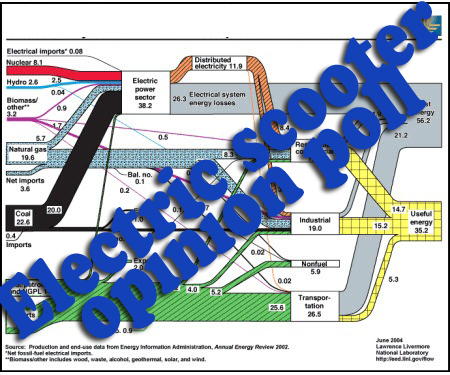Howdy folks! I’m hoping you can help me out here. I’m doing a bit of research to try to find the tipping point for electric scooters. Most electrics to date have been too slow, and too expensive. I don’t think the parallel hybrid (gas / electric) scooter is going to stick around very long because the losses (more complexity, more weight, less storage space) outweigh the gains (longer distances, lower fuel expense).
So, if you could do me a favor and take this 4 QUESTION POLL, it could really help developers and manufacturers have a goal to aim for; and they REALLY ARE LISTENING! (I’ve had two manufacturers request this poll already).
I realize that the expectations could be different for people who currently ride scooters and people who don’t; and in hindsight I wish I would have added “do you currently have a scooter” as a fifth question… C’est la vie. Thanks in advance for your help! I hope to get 1,000 respondents before the month is up. *fingers crossed*
















14. October 2010 at 12:21 pm
I will post this around, but the only people I know who would take an interest are current scooter riders.
14. October 2010 at 1:36 pm
Hi! I like your survey. Where Vectrix messed up is they made a huge and heavy scooter that would go 60 but only for 20 miles and cost $10,000. We looked at them carefully and said No way! Now they’re bankrupt. We see that customers in our scooter shop would like a small electric scooter they can ride a new miles to work, charge up at work and/or at home, just ride in town on back streets and doesn’t cost a huge amount ($3K) I’d love to sell such an electric scooter and we get questions about them all the time.
14. October 2010 at 1:47 pm
@leo, having lived in Seattle and Portland, I can tell you it is people who have never owned a scooter who are the prime candidates for electrics. These cities are full of people who wish to rub others’ noses in their green-ness… they drive Priuses (and it must be a Prius… a Fusion Hybrid won’t do, because it looks like a regular Fusion) and snort contemptuously at people in the grocery store who don’t use canvas bags.
I hate to sound like a broken record, but electric scooters are less useful (and less green) than a 125cc gas scooter. The U.S.’ antiquated electric grid will be brought to its knees by the exponential increase in demand for electricity brought about by large-scale adoption of electric vehicles (and a large-scale upgrade is not in sight in the forseeable future).
But then, the people who’ve requested your survey smell an opportunity to make a whole bunch of money, and that’s what a business is all about. And I would change my tune if someone make an electric that equaled the performance of my departed PX150: 130 miles on a charge, ~45 mph top speed. And a battery small enough and cheap enough to swap out with a spare, so one can be in the bike, and one at home in the charger. Kinda like my camera. That solves the recharge-time issue. It only takes a minute to fill a gas tank, and that’s an issue that will never be overcome…
__Orin
Scootin’ Old Skool
14. October 2010 at 6:32 pm
Interesting that you’re asking these questions right after I bought a second-hand Oxygen Lepton scooter. The 28 mph top speed is comparable to a stock moped and requires a moped-like riding strategy, such as avoiding main roads and making use of bike lanes. I recently changed the pipe and jets on my 2-stroke moped so it could hit 45 mph so I wouldn’t have to ride like that. Upgrading the Oxygen may be possible, but it’s not clear how to go about that.
The Oxygen’s range is optimistically 20 miles with lead-acid batteries, so I can use it for errands and for commuting, but not for my weekend trips into the local mountains, which typically range from 40 to 100 miles (and require a top speed around 45 mph). A range of only 20-30 miles might not be a real problem if the scooter was light, compact, and cheap enough to leave room for a gas scooter for longer trips. Of course, one might as well get an e-bike then.
Charging the scooter turned out to be more challenging than I expected simply for access reasons. My apartment has no outside outlets, so I park the Oxygen in a corner of my kitchen. Getting it over the stoop requires quite an effort because it has a belly full of lead. I would suggest fitting a small lithium-phosphate pack to electric scooters instead of the heavier but cheaper equivalent lead-acid pack because the mass quickly gets unreasonable.
Ideally, the battery pack would be broken into removable modules weighing no more than 10-15 kg and incorporating their own chargers. That would allow users to carry them inside for charging while the scooter is parked outside (and conveniently immobilized) and would make it possible to carry a spare module for longer trips.
This is the first vehicle I’ve bought in a while that didn’t need a carb cleaning once I brought it home. It doesn’t seem to need anything except a charge and air in the tires. Not needing a lot of maintenance is nice, but I would prefer a means for troubleshooting and upgrades. Imagine if riders could plug their phone or laptop into the main board to read error codes or remap the motor controls. Oxygen seems to have planned on dealer support always being available, and now years later that is a serious limitation.
The most pleasantly surprising thing about riding the Oxygen is that it accelerates like a good 50cc scooter, but without all the raspy engine noise. Maybe it’s just the novelty, but it feels like a fundamentally different riding experience. It didn’t take me long to figure out how to work the regen so I barely needed the friction brakes at all. In fact, I prefer riding the Oxygen to riding one of my gas bikes for the trips that fall within its range.
15. October 2010 at 10:20 am
Leo! Thanks for helping spread the word. We’re getting some solid responses right now.
Meg! I think you’re perfect electric scooter is “around the bend”. All the pieces are available (light weight frame materials like aluminum alloys, steel foam and carbon fibre), new, more powerful, longer lasting, quicker charging lithium nickel manganese oxide batteries, smaller and more efficient Yasa motors with automated manual transmissions). Now it’s just a matter of having someone put them ALL together in one scooter (or bike) and finding a way to make it affordable. The manufacturer might need to petition to get the vehicles subsidized so that they are affordable to consumers at first; banking on recovering the R&D and Tooling costs within the first few years of introduction with the hopes that when the subsidies run out, the bikes will be affordable for everyone. You’re likely to see this pop up on the scene as a guerilla garage experiment first. *fingers crossed*
Orin! You’re right. The prime candidates for electrics right NOW are people who don’t already realize the fun, efficiency and practicality of a gas powered scooter. For most of us (right now) it’s not that big of an upgrade. We’d pay a lot more for lesser performance, but on the bright side? Less maintenance. Thanks for sharing your take on the situation.
GenWaylaid! The Oxygen Lepton seems pretty affordable, considering the tech that’s included (specifically, Regenerative braking). I think a lot of people will start to dig that “fundamentally different riding experience” you’re talking about once the right electric comes around… once you have an electric that impresses the SCOOTERISTS? The paradigm shift will have begun.
15. October 2010 at 11:22 am
Let’s see what we can do with this one…
15. October 2010 at 5:56 pm
For me it would need to perform on par with a gas scooter, have a range of 50 miles or so between charges and cost the same or less than a comparable gas scooter. Yeah, it would be cheaper to operate but I’m not spending much tp begin with.
15. October 2010 at 9:26 pm
how would you like a three wheel electric scooter that would go 40 miles on a 4-6 hr charge and trave at speeds up to 25+ miles per. hr. and be able to ride on the street or on the sidewalk or go right into the stores and be legal and by the way not need to regester or have insurence or drivers licence and all for less then $2000.00 if so see web. site bobsmobilityfreedom.com
15. October 2010 at 10:25 pm
Hey Bob! I don’t normally allow spam comments, but it looks like you’ve got a product that could benefit some people, so I’ll let it slide. ;)
Cheers!
16. October 2010 at 11:40 am
We have been interestedf and on several occassions havd them in stock. Never a selling item dispite gas shortage, gas price hikes and economic & environmental interests.
Scooters are too heavy, battery replacement not common or reasonably priced. Title & registration very confusing to some officials as they can not easily classify into a current cc class for titling & licensing requirements.
This has never been a profitable or easy type vehicle to sell, service or get parts or warrsanty for. The distributing companies don’t stay in busdiness long enough.
Name (EVT) stayed the same but the importer and distributor changed.
16. October 2010 at 10:09 pm
My scoot gets gas mileage that’s too good to trade for the cost and hassles of an electric scooter. It’s an ’82 Honda C70 Passport that gets about 90 mpg. That’s running at full throttle a lot of the time. It can’t quite handle a 40 mph uphill climb with a headwind, but a Yamaha Vino 125 gets similar mileage and should handle the hill very well.
17. October 2010 at 3:14 am
Hi There we are currently working on a project for a all terrain electric scooter, we have found most people down under (in NZ) expect good power 50mph and at least 50mile range and 3-4 hour charge ,hope this helps
19. October 2010 at 3:11 am
Unless we see a huge leap in battery technology along with a drastic price decrease, I don’t think the future of scootering (or cars for that matter) lays in electric. The cost of the tech is a small hurtle compared to the changes required to use electric. By the nature of charge times and range available, electric is too limiting for replacement of gas engines. Without a common standard for “fuel” (in this case battery packs not just electricity), there is no way to top up quickly when running low. Parking the bike for hours to charge up is not always viable. Super capacitors might be a solution to this in the long term since they are able to recharge quickly, but I don’t see them them being able to provide realistic storage in the near future for anything other than short commuting hops such as commuting.
Batteries also degrade over time and are a considerable portion of the cost of an electric vehicle. Replacement of the batteries negates the fuel savings and any “green” environmental impact.
A more reasonable approach is the fuel cell since it is capable of refueling similar to gas vehicles. The major difference is that the hydrogen is under pressure and requires a seal between the fuel tank on the vehicle and the pump at the filling station. Refueling times are comparable to gas. One of the big changes required for the fuel cell to take off is the necessary infrastructure (fueling stations) to be in place as any new system would need. While we can put electrics “on the grid” now, if converting a large portion of the gas guzzlers over to electric would require substantial investment in power generation and delivery too. By refueling in minutes (rather than hours), fuel cells provide the same ability to travel, refuel, travel, refuel that we enjoy with transportation today thereby not limiting us to a commuting only vehicle. If I wanted to hop on a scooter and ride for hours (or days) at a time, using a fuel cell I don’t have to worry about scheduling most of the time for charging rather than riding.
19. October 2010 at 8:52 pm
It always comes down to infrastructure. We have an excellent infrastructure for petroleum, a pretty good start on electric, and some natural gas if you know where to look. I’m not keen to start building a whole new infrastructure around hydrogen.
It’s actually not that hard to make a car electric, as long as you don’t go all the way. The Chevy Volt and other plug-in hybrids can be driven like normal cars, but they grab as many gas-free miles as possible by charging whenever it’s convenient.
The plug-in hybrid approach could find a niche on maxi-scooters. They have both the carrying capacity and the price range to accommodate two drive systems. The gas mileage of all scooters is already so good, though, that a hybrid would be a hard sell (short of a “Road Warrior” critical gas shortage).
I’m starting to get the impression that electric scooters should target 150-250cc machines for performance and leave the lower end of the market to electric bicycles and mopeds. The range will have to be substantial, maybe 60-100 miles per charge, to handle longer commutes. That suggests a battery capacity larger than the Vectrix and smaller than the Brammo Empulse. On the upside, midsize scooters are more likely to be garaged, so removable battery packs are not necessary. Compatibility with Level 2 electric car chargers (i.e. a J1772 plug) would be very useful, though.
21. October 2010 at 8:38 pm
@Bill:”Replacement of the batteries negates the fuel savings and any “green” environmental impact.”
It is a faulty assumption that the batteries will be thrown out, in most states that is now illegal. Most batteries will be reclaimed/recycled and will have a minimal environmental impact.
25. October 2010 at 12:35 am
It seems Honda has already done some R&D…. are you suprised?…..me neither!!
This Google Patent link might be of interest to some.
Ive done some digging and the Inventors do work for Honda
Battery Ruckus
http://www.google.com/patents?id=OfTNAAAAEBAJ&zoom=4&rview=1&pg=PA2#v=thumbnail&q&f=false
26. October 2010 at 3:44 pm
I’m posting this around too but I also find that more people in this area (Chicago) are interested in gas scooters…
27. October 2010 at 5:03 pm
My first experience with a scooter was a EVT Z-30 (electric). I took your survey but it didn’t address the real reason I would NEVER buy another electric scooter. I could not get anyone to touch it when I had a problem. Every scooter shop in town called it a child’s toy and was rude when I ask them to change out, something small like a valve stem or the brake caliber. The electric scooter is now collecting dust in a mini storage, and I ride a Piaggio MP3 500. There is NO WAY I would ever go back to an electric scooter. In every way shape and form the MP3 is a million time better!
3. November 2010 at 4:04 pm
I’ve got some serious safety qualms about current electrickery powered scooters, mostly that they look faster than they are, and are prone to going slower as the batteries deplete.
But mostly that they tend to be ridden not by economically-aware budget commuters like scooter riders, but rather by lentil-eating, tree-hugging, sandal-wearing self-important eco-warriors who actually think wearing open-toed shoes and beads entitles them to road space and consideration by other road users. The problem is to the rest of traffic-dom you are just idiot sloths getting in the way, and far from saving the planet you have simply been suckered by the greatest con ever perpetrated on the masses.
Frankly, to remove all remaining objections I’d like to see not only equivalent power and duration to existing ICE technology, with equivalent refresh time, but also a positive campaign to let these airy-fairy, reality-bypassed, hand knitted jumper types know that they have been duped.
Then it should be simple to get back to the business of building a better scooter…
7. January 2011 at 6:40 am
Maybe we should separate scooters into different classes.
I consider a scooter to be a sub 50cc 2-3 wheel machine that needs no license, tags, inspection or insurance. A 150cc machine that’s basically the same size as a small motorcycle and needs tags, plates, a license and insurance isn’t really a scooter. It’s just a slightly, very slightly smaller motorcycle. In fact I’m pretty sure you can buy an actual motorcycle that’s 125cc. So what make a 125cc scooter a scooter? The shape? It’s really the main difference I see between the two to be honest.
29. March 2011 at 5:19 am
The Flyer uses a hi-torque finned Electro Drive 24-volt brushless motor with built-in electronic pulse width modulated speed controller. Superior torque for fast starts and hill climbing. Heavy duty, cast metal heat sinks surround the motor to reduce overheating when climbing long hills.